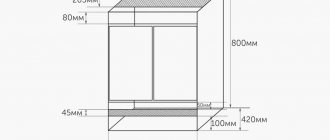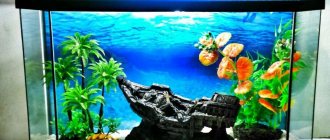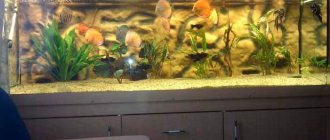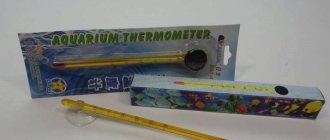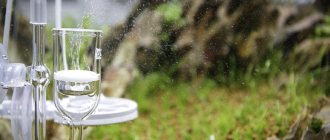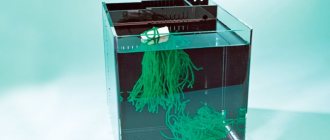Home/AQUATERRARIUM/Do-it-yourself aquarium for a red-eared turtle
When choosing a pet for yourself, it is important to know how to care for it and what to feed it. Be sure to arrange and choose comfortable housing. The right aquaterrarium for a red-eared turtle is the key to the health of your beloved pet.
Description of the species
Ornate turtles (Chrysemys) are divided into eight species. Their representatives live in various bodies of water in South and North America. The most famous of them is the beautiful and slender red-eared turtle.
Its shell reaches 28 cm in length. The pattern on it and coloring are individual for each individual. A characteristic feature of this species is two orange, red or yellow spots that are located on the sides of the head.
These turtles prefer shallow, swampy waters. In their homeland, they are more often called “red-eared sliders” for their special manner of running away from danger at very high speed, sliding their belly along the surface of the soil in order to quickly dive into the water.
Ultraviolet
In order for a turtle to have a beautiful, shiny and pleasant-to-touch shell, they need calcium. This mineral enters the body with food, but is not always well absorbed. To absorb calcium, the turtle needs ultraviolet light. In summer, it is enough to place the aquarium in indirect sunlight. But in winter you have to use an ultraviolet lamp. 3-4 hours of lamp operation per day is sufficient.
Terrarium for a red-eared turtle – how to organize it correctly?
All owners of such turtles and those who are just planning to have them need to know that they require not only water treatments, but also warmth on an island of land, “sun”, which you create yourself. I would also like to note that it is absolutely not necessary to spend large sums of money to purchase a fully equipped “home” for your pet. It’s not difficult to make an excellent terrarium for a red-eared turtle with your own hands. It will become comfortable and cozy for your pet if you take this work seriously.
What helps maintain humidity in a terrarium?
Keeping many exotic pets requires a certain level of humidity in the terrarium. For some animals, high humidity is indicated, for others, humidity is contraindicated. For example, hamsters will feel great in dry sawdust, Achatina snails vitally need a wet extract, mantises will not be able to survive if there are drops of condensation in the terrarium.
The required soil moisture for pets is different:
- Humidity for Achatina snails is checked in this way - squeeze a handful of soil in your hand, if water drips, then the soil is waterlogged. Achatina snails react negatively to high humidity: they hibernate, become lethargic, and lose their appetite.
- Moisture is also important for ants. You can determine the level of sufficient moisture in the formicarium as follows: if perspiration appears on the walls, stop spraying.
- The soil in the praying mantis terrarium should be sprayed rarely. It should be slightly damp. How often this needs to be done is difficult to say for sure, it depends on the air circulation in the terrarium.
- The optimal humidity level for the tarantula spider is 35-60%.
A hygrometer determines the humidity level in the terrarium
What should a “home” be like for a turtle?
Terrariums for red-eared turtles represent a mandatory water space and an island of land. But you should know that the pool for a turtle should be three times larger than its dry part. Therefore, such animals are kept in aquaterrariums. These are ordinary aquariums that can be purchased at almost any pet store. Usually their average volume is at least 100 liters.
The layer of water should be 40 cm. To prevent your pet from traveling around your home, the terrarium for the red-eared turtle must be covered with a glass or plastic sheet with perforations, which serves for sufficient air exchange.
Health, disease and prevention
As a rule, most pets, including the red-eared turtle, get sick in most cases due to improper care and maintenance. Dirty and untreated water quickly leads to the fact that the turtle begins to feel unwell, as many harmful microorganisms appear in it. In this case, it is necessary to raise the temperature in her home by a couple of degrees in order to optimize the functioning of the immune system. It is also necessary to ensure that the animal does not experience a lack of moisture (water), otherwise, against this background, kidney failure begins to develop, leading to disastrous consequences.
The fact that something is wrong with the turtle may be indicated by its behavior. When it swims, it can fall on its side or even sink to the bottom. If there is a suspicion of infection, then it is advisable to treat all items for caring for the reptile with an antiseptic that will not cause harm to the animal. Symptoms of bacterial damage are associated with the appearance of edema and necrotic changes. Such diseases require the use of antibiotics for treatment. In this case, you will have to completely replace the water in the aquaterrarium.
If a turtle is injured, an infection can enter its body, leading to blood poisoning. As a result, the animal’s paws turn red, and the turtle becomes quite lethargic and inactive. This type of disease is practically not curable, especially on its own, so you will have to visit qualified specialists. If treatment for your pet is not started in a timely manner, the outcome can be very disastrous.
To prevent this from happening, it is necessary to take preventive measures, such as:
- Inspect your turtle daily.
- Clean the aquaterrarium regularly.
- Change the water regularly.
- Organize proper healthy nutrition.
- Avoid hypothermia.
- Monitor the operation of the heating, lighting and filtration systems.
- Observe personal hygiene rules.
- From time to time, clean the turtle's shell of algae.
- Adhere to the rules for keeping sick or newly purchased animals (quarantine regime).
- Avoid contact of a sick animal with both family members and pets.
- Constantly monitor the turtle's movements outside its home.
- Periodically turn on the UV lamp and expose it to sunlight.
- From time to time, show the animal to a veterinarian.
In case of improper nutrition, the turtle begins to experience a lack of calcium, which leads to curvature and softening of the shell. If there is too much calcium deficiency, your pet may die. In such cases, the veterinarian prescribes drugs with a high calcium content in injections. It is also necessary to know that calcium is absorbed due to the presence of vitamin D in the animal’s body
Vitamin D is produced as a result of UV exposure, so it is very important to regularly turn on the UV lamp
Pond slider. House maintenance. Interesting Facts.
Watch this video on YouTube
Preparing the water
As already mentioned, the water in a turtle house should be 40 cm deep. This is necessary so that your pet can maneuver freely in it. The terrarium for red-eared turtles should be cleaned quite often, but it should be taken into account that the water for it must settle for at least 5 days. It should not be changed completely, but partially - about one third of the volume. This procedure should be performed at least once a week. To replace, you must use water at the same temperature as in the terrarium pool.
The main mistakes when keeping land turtles at home.
- There is no need to keep your turtle on the floor. With this method, drafts, dust, dehydration, infectious diseases (including deep mycoses), ingestion of foreign bodies and injuries cannot be excluded.
- You cannot bathe a turtle and then release it to the floor. A temperature difference of just 10°C can cause a cold.
- You cannot make a nest for a turtle out of woolen fabric.
- No contact with other pets is allowed.
- You cannot immediately plant a “friend” or “girlfriend” in the terrarium. If they are purchased for the company of a healthy turtle, quarantine is required for at least a month.
- You should not leave your turtle outside unattended.
- Do not use sand, sharp stone chips, small sawdust as soil, or simply keep the turtle on a smooth surface.
- There is no need to feel sorry for a turtle planted in a terrarium if it scratches “plaintively” there. Digging is an urgent physiological need for a turtle. In nature, she does this most of her “free time.”
- If a turtle moves away from the light, this does not mean that it does not need to be warmed.
- Turtles drink only if there is not enough water in their food. But they prefer to swim and “go to the toilet” in water. Water should be in the terrarium at all times.
- You cannot feed your turtle milk, bread, or minced meat.
- You cannot give only one type of food. Food sources of provitamins A - carrots, tomatoes, red peppers and raw liver - must be fed, at least occasionally.
- Feeding containing calcium salts (ordinary calcium gluconate tablets are almost not absorbed) must be given without fail and constantly.
- You should not give vitamin preparations (primarily those containing vitamins A, D3, B12) and selenium on the “eye”. Vitamin D2 should not be given.
- There is no need to smear the turtle with oil preparations, much less vitamin A.
- Hibernation is not necessary for turtles, and sometimes it is harmful.
- After handling the turtle or cleaning the terrarium, you should wash your hands, as the turtle can carry salmonella. With very rare exceptions, turtle worms are harmless to humans.
- If the turtle does not seem completely healthy, you need to contact a veterinary clinic as soon as possible. Many diseases in the main stage are difficult to treat.
We recommend the following books as a guide:
- S.V. Kudryavtsev, S.V. Mamet, V.E. Frolov. “Reptiles in a terrarium”, Hobbybook, Selskaya Nov, 1995.
- D.B. Vasiliev. “Turtles. Maintenance, diseases and treatment”, Moscow, “Aquarium”, 1999.
Veterinarians at our clinic
Neighborhood
A do-it-yourself terrarium for red-eared turtles allows your pet to be close to aquarium fish. Of course, it is undesirable for them to be in the same “house” - this can provoke frequent conflicts between its residents. In this case, it is better to use a vertical glass wall that will separate the aquarium for the fish and the terrarium for the turtle. There should be holes in the partition so that water can pass freely, but residents of the aquaterrarium should not penetrate through them into the neighbors’ territory.
In the part where the fish will be located, the bottom of the “house” can be decorated with special plants. Don’t bother creating a beautiful design on the turtle’s territory; it won’t appreciate your worries and will happily eat the green spaces.
Interior arrangement
In addition to the walls and bottom, the house must have lighting, heating, and a separate place for food and climbing.
How and what to make the bottom from
Ideally, the bottom should be covered with a layer of soil corresponding to the pet’s natural habitat. Coarse sand and small pebbles are suitable. It is better to place a rubber mat under the bedding (for example, used for bathrooms).
It is advisable to change the soil fill once every two weeks, completely updating the contents. Or by thoroughly washing and cleaning the old one.
If the reptile swallows pebbles, it is necessary to replace them with larger ones.
A good option would be to make a heated floor for your pet (for example, electric), placed under a rubber mat, so that the turtle cannot get to it and damage the wires. This system will allow you to maintain favorable temperature conditions for the reptile to live all year round.
Lighting and heating
In their natural habitat, turtles live in a temperature range of 30 degrees C. Therefore, it is necessary to create the same temperature in the home. At the same time, in the common room there is no need to increase the air temperature at all.
Daylight hours for reptiles should not be around the clock, so the lamps should be turned off at night.
In order to maintain a high temperature in the turtle’s home, it is necessary to heat the air with incandescent lamps (the power should be no more than 60 W) or an ultraviolet lamp. The second option is preferable, as it solves three problems at once: lighting, required air temperature, sunlight.
To ensure that the turtle does not get burned by the lamp, the lighting device must be placed at a distance of at least 20 cm from the terrarium.
Arranging a place for food and drinking water
It is better to place the feeder and drinker in a warm part of the home. The dishes must be selected with low sides (so that it is convenient for the turtle to reach them), made of strong material (so that the reptile does not crumble it or choke on debris), with non-sharp edges (so that the reptile does not get scratched) and heavy enough (so that it does not turn it over).
Read with this
Island for relaxation
Terrariums for red-eared turtles must have a piece of land where your heat-loving pet can rest and warm up. Its size should be equal to approximately a quarter of the entire home.
Such an island is usually a pile of pebbles secured with sealant. Wooden parts should not be used, since this is an unstable material and, by absorbing water, it will create conditions for the appearance of mold. But natural driftwood, as well as tree bark, can be used for these purposes.
Be sure to install lamps above the island. By warming up under them, the turtle strengthens its immune system. You can use a special device for these purposes - a thermostat connected to a glass tube. It is very practical and affordable.
When creating a terrarium for red-eared turtles with your own hands, you can save time by purchasing a ready-made island at a pet store. These devices meet all the requirements of the inhabitants of the terrarium - they have a rough surface made of waterproof plastic so that the turtle’s paws do not slip on it.
A terrarium for red-eared turtles must meet safety requirements - pebbles should not have sharp edges. Their size should not be too large to prevent animals from swallowing them. It is better to replace the green plants of a regular aquarium with various driftwood and caves.
Remember that when you choose a red-eared slider as a pet, you are responsible for its quality of life.
Stages of work
Cut pieces of glass must be pre-treated - rub the sharp edges with sandpaper. The cuts should be as even as possible, a discrepancy of no more than 1-1.5 mm is allowed, otherwise it will be difficult to achieve tightness of the joints. When sanding, sharp particles of glass dust can get into your lungs, so you need to wear a protective mask when sanding the edges. At home, it is better to use the bathroom for work; a constantly running shower helps to quickly wash away dust. After preparing the parts, perform the following steps step by step:
- A strip of tape is glued to one of the sides so that it extends beyond the edge.
- The second part is carefully lowered onto the sticky side of the tape, then both parts are lifted and folded at an angle, with the tape inward.
- Using tape, all four sides of the aquarium are assembled and placed vertically - you need to check that the glass fits as tightly as possible to each other and that the sides are parallel.
- All joints are degreased with alcohol and coated with glue-sealant in two layers - each layer is leveled using a piece of paper; To prevent the glue from staining the glass, it is recommended to glue additional vertical strips of masking tape, which are removed after completing the work.
- Glue cannot be saved, it must fill the joints completely - for a better result it is better to use a special gun that squeezes out the glue in even portions; If the adhesive layer is not dense enough, a joint leak may form under water pressure in the future.
- A part of the bottom of the aquarium is laid on top of the structure, first on small droplets of silicone, then when the evenness of the joints is checked, they are also degreased and coated with silicone.
- The aquaterrarium is left to dry for several hours, then carefully turned over.
- All tape is removed, traces are washed if necessary, and internal joints are degreased.
- All seams are coated with glue in two layers, then they are also allowed to dry.
- The aquarium is left to dry for at least a day, after which water is filled and left for several days to check for leaks. Corners usually leak - if a leak is detected, the water is drained, the joints are dried with a hairdryer and coated with another layer of sealant.
After drying, excess silicone is carefully cut off using a stationery knife. A large aquarium can be reinforced with stiffening ribs - to do this, you need to place horizontal strips of glass or plastic 4 cm wide on the wide walls in the corners. 3 cm are removed from the top of the side; fastening is done using glue. In the future, these strips can be used as a support for a protective mesh or cover.
DIY bridges for turtles
Many people have probably seen bridges for turtles in stores. These are environmentally friendly and safe products that are usually held on the walls of the aquarium using suction cups.
You can make such bridges for turtles with your own hands. The main condition for this is not to use untreated tree branches or driftwood. The fact is that pet stores sell bridges treated with a special impregnation that prevents wood from rotting. If you put an ordinary branch into the aquarium, the water in it will soon deteriorate and can even harm the health of the turtle in the same way as the wrong one.
DIY houses for land turtles
One turtle measuring 6 to 15 cm requires at least 0.5 m² of living space. As a terrarium for a turtle, you can use a low, long, wide and closed box with holes for ventilation.
The box can be made of wood, non-toxic impact-resistant plastic, glass or plexiglass. It should be borne in mind that these animals love privacy, so when choosing a glass house for them, only one wall should be left transparent. In addition, turtles often do not see transparent glass walls and can hit their shells against the glass, trying to pass through it.
However, most often turtles are kept in glass aquariums equipped with a shelter-house. Half of a clay flower pot, cut vertically, or half of a coconut would be perfect for such a house. You can make houses for land turtles with your own hands, or you can purchase them in specialized stores.
DIY plywood house
To work you will need:
- 4 identical plywood rectangles for the walls of the future house.
- One square piece of plywood for the roof.
- Glue for working with wood.
- Tools for woodworking.
- In two wall parts, wide arches should be cut into which the turtle will fit freely. If your animal is still small, it is recommended that when cutting out the entrance holes, make them the size of an adult animal. Otherwise, after a few months you will have to increase the size of the arches.
- Then the wall parts are connected using glue, and the roof of the house is glued on top. After treating with glue, the new home should dry and weather well.
- After about two days, you can move a new tenant into it.
Straw basket house
To arrange such a house you will need a rectangular basket, which can be purchased at any interior design store. Lay the basket on its side and make a bedding. Install heating and ultraviolet lamps above the house.
It is necessary to ensure that there is no draft in the terrarium and that the air temperature is maintained within 22˚C. Turtles are very sensitive to cold and can get pneumonia.
Have you made an island, a bridge, a house for your turtle? From what materials? Tell us about it in
Red-eared turtles are aquatic species of these animals. To keep them, you need a large and comfortable aquarium. It is correct to call it an aquaterrarium, because such a reservoir contains water and has access to land.
This animal is demanding about its place of residence. Therefore, you need to know how to arrange it in such a way as to create a natural habitat for it. Only in this case will this animal live a long life, free from disease.
"...lonely, like an island in the ocean." Rules for building sushi
If you are setting up a beach for a turtle with your own hands, then the ideal ratio of land and water is 1:4. That is, land should occupy 25% of the area of the aquaterraria. This is provided that the shore or island is no less than 4 turtle sizes. If a whole flock of agile turtles lives in an aquaterrarium, then the land area should be several times greater than the total size of all the turtles.
1.
Access to land, that is, a ladder or ascent, should be as convenient and safe as possible. Excessively steep inclines and sliding surfaces should be avoided. The ladder must have a corrugated and rough surface. The angle of elevation should be as obtuse as possible. It will be good if you build an island for the red-eared turtle with your own hands with an angle within 160°.
2.
The shore should rise above the water surface by at least 25-50 (mm).
3.
The land must necessarily be warmed up and illuminated by ultraviolet radiation. You can read how to properly organize lighting and heating of the shore here.
How to build land?
A shore can be created:
- Based on suspended structure
- With support on the bottom of the reservoir
Suspended structures have a more practical and aesthetic design. That is, a do-it-yourself hanging island for a turtle is a neat and sophisticated island that is created for the pet’s maximum comfort.
The shore supported by the bottom is more massive. Such designs look very natural and natural. Islands supported on the bottom are most often presented in the form of a large stone sculpture, which is simply immersed in a body of water, so that it looks out of the water by 25-50 (mm) and has at least one flat side along which the turtle will climb onto the island .
1.
If you are creating a suspended bank for a turtle with your own hands, then you can use the following as building material:
- Ordinary glass with rounded edges
- Tile without sharp edges
Why these materials? – The fact is that glass and tiles are completely hypoallergenic materials that do not change the chemical and structural composition of water. If you take plastic or wood impregnated with a water-repellent solution, then the water in the aquaterrarium will slowly but surely be poisoned by all kinds of toxins.
2.
If you are building an island for a red-eared turtle with your own hands with support on the bottom, then you can use the following material as material:
- Large pebbles. These are large rounded blocks. You can take not just one pebble, but 3, 4 or all 5
- Solid natural stone
- Granite statue
- corral reef
The advantage of these materials is their natural and natural texture. Stone blocks do not need to be processed or otherwise brought to perfection. The disadvantage of these materials is their massiveness. That is, if the suspended islands do not occupy the space of the reservoir. then the land resting on the bottom of the reservoir takes away precious water space.
Examples of suspended islands
1.
If you are building a shore for a turtle with your own hands with a suspended structure, then it is best to fix the island with glue to the wall of the aquaterrarium. This method is the simplest and most effective. But not everyone likes the use of “chemistry” in an aquaterrarium. The fact is that the glue can come into contact with water, which can lead to intoxication of the reservoir.
2.
An alternative to glue are vacuum suction cups. But this solution does not have the highest reliability. The suckers may fidget along the wall of the aquaterrarium, or they may completely weaken and drown the land.
3.
The glass or tiled surface must be covered with corrugated material with a high level of roughness. Some people install carpet with a plastic backing and non-absorbent pile over a smooth surface. Others, when building an island for a turtle with their own hands, equip the surface with pebbles, which are fixed with glue.
Material
And others need a small, well-heated island of land, since from time to time turtles need air to breathe and also need a place to rest. Without this, turtles may drown. Also, resting on land is good for the turtle's health; it does not develop some shell diseases. The island should be illuminated with heating conventional and ultraviolet light bulbs.
The size of the resting place should be 3-4 times larger than the size of the turtle itself or 2 times larger than the sum of the sizes of all available turtles.
Some species of turtles most like shelters that are under water. If you can make a similar shelter on the island, the turtle will prefer it. Aquatic turtles do not require shelter directly on land.
"...lonely, like an island in the ocean." Rules for building sushi
If you are setting up a beach for a turtle with your own hands, then the ideal ratio of land and water is 1:4. That is, land should occupy 25% of the area of the aquaterraria. This is provided that the shore or island is no less than 4 turtle sizes. If a whole flock of agile turtles lives in an aquaterrarium, then the land area should be several times greater than the total size of all the turtles.
1. Access to land, that is, a ladder or ascent, should be as convenient and safe as possible. Excessively steep inclines and sliding surfaces should be avoided. The ladder must have a corrugated and rough surface. The angle of elevation should be as obtuse as possible. It will be good if you build an island for the red-eared turtle with your own hands with an angle within 160°.
2. The shore should rise above the water surface by at least 25-50 (mm).
3. The land must be warmed up and exposed to ultraviolet radiation. You can read about how to properly organize lighting and heating of the shore in this section.
DIY shore for an aquatic turtle
How to build land?
A shore can be created:
- Based on suspended structure
With support on the bottom of the reservoir
Suspended structures have a more practical and aesthetic design. That is, a do-it-yourself hanging island for a turtle is a neat and sophisticated island that is created for the pet’s maximum comfort.
The shore supported by the bottom is more massive. Such designs look very natural and natural. Islands supported on the bottom are most often presented in the form of a large stone sculpture, which is simply immersed in a body of water, so that it looks out of the water by 25-50 (mm) and has at least one flat side along which the turtle will climb onto the island .
DIY turtle island
1. If you are creating a suspended bank for a turtle with your own hands, then you can use the following as building material:
- Ordinary glass with rounded edges
Tile without sharp edges
Why these materials? – The fact is that glass and tiles are completely hypoallergenic materials that do not change the chemical and structural composition of water. If you take plastic or wood impregnated with a water-repellent solution, then the water in the aquaterrarium will slowly but surely be poisoned by all kinds of toxins.
2. If you are building an island for a red-eared turtle with your own hands with support on the bottom, then you can use the following material as material:
- Large pebbles. These are large rounded blocks. You can take not just one pebble, but 3, 4 or all 5
Solid natural stone
Granite statue
corral reef
The advantage of these materials is their natural and natural texture. Stone blocks do not need to be processed or otherwise brought to perfection. The disadvantage of these materials is their massiveness. That is, if the suspended islands do not occupy the space of the reservoir. then the land resting on the bottom of the reservoir takes away precious water space.
Building an island in an aquaterrarium for a turtleExamples of suspended islands
1. If you are building a shore for a turtle with your own hands with a suspended structure, then it is best to fix the island with glue to the wall of the aquaterrarium. This method is the simplest and most effective. But not everyone likes the use of “chemistry” in an aquaterrarium. The fact is that the glue can come into contact with water, which can lead to intoxication of the reservoir.
2. An alternative to glue are vacuum suction cups. But this solution does not have the highest reliability. The suckers may fidget along the wall of the aquaterrarium, or they may completely weaken and drown the land.
3. The glass or tiled surface must be covered with corrugated material with a high level of roughness. Some people install carpet with a plastic backing and non-absorbent pile over a smooth surface. Others, when building an island for a turtle with their own hands, equip the surface with pebbles, which are fixed with glue.
Related material: What water is suitable for red-eared turtles?
